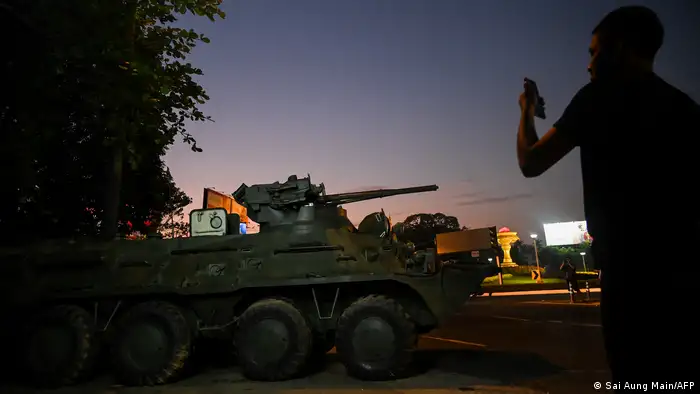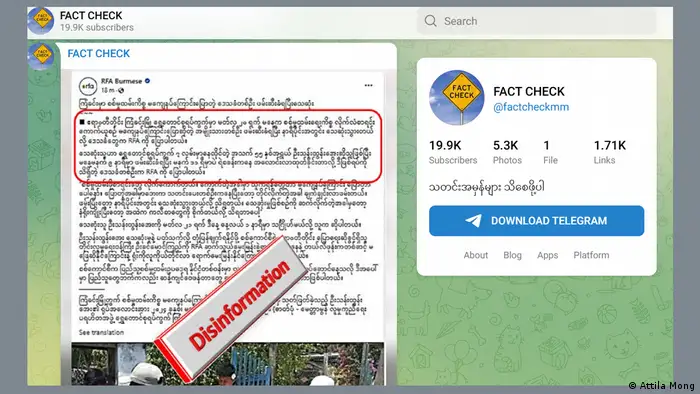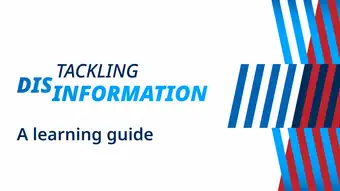Digital Rights in Myanmar
How Myanmar's military regime weaponizes disinformation against independent media
Myanmar's military has established a network of Telegram accounts, which work in a synchronized way to support its propaganda and counter the impact of independent media.
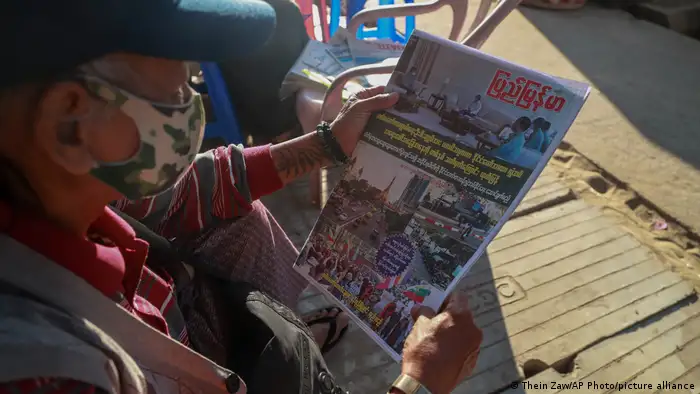
This newspaper front page, dating from Myanmar's February 2021 coup, says that power has been transferred to the military chief
More than three years after the 2021 coup in Myanmar, the military is weaponizing social media and disinformation against independent media in the southeast Asian country. To find out more how the military is doing this, DW Akademie conducted an interview with The Red Flag, a team of activists and academics advocating for digital rights in Myanmar.
The team focuses on research, social media monitoring, combating mis- and disinformation and promoting media and information literacy. For security reasons, DW Akademie is keeping the names of those involved in the interview anonymous.
DW Akademie: How does independent media operate in Myanmar?
More than three years after Myanmar's military coup in February 2021, the country's independent media operates in harsh circumstances. The military revoked the licenses and outlawed nearly all independent outlets, it jailed dozens of journalists making the country the world's second worst jailers of journalists and continues to intimidate and threaten those who defy the rules and report independently under these harsh circumstances.
The tactic of repression employed by the military regime against independent media serves several purposes.
- Its primary aim is to create an information vacuum, enabling the regime to disseminate its own narratives more effectively. Through channels like state-controlled or pro-military media, influencers loyal to the regime and selected social media platforms, the military can spread its own propaganda and, in some cases, promote ethnic hatred (as it was the case also before the coup).
-
It is also targeting the public. Members of the audience of independent media, anyone who provides information to journalists, are threatened with criminal procedures. This limits journalists' ability to gather and verify information and counter the regime's narrative.
How has the military regime's approach to independent media changed?
Despite this tactic of repression, and the military's attempts to eradicate independent media, these outlets remained resilient. They maintained their teams, although their staff moved to other countries particularly neighbouring countries, and they continue to deliver independent reporting adhering to professional standards just like before the coup.
They work with journalists on the ground, who — amidst significant security threats — continue to report for these outlets even from areas under military control, with some of them operating covertly to evade potential arrest, often relocating and assuming cover jobs to conceal their involvement in media. Journalists and editors working for independent outlets adapted to these limitations. Besides traditional journalistic skills to gather and verify information, they apply new skills as well. They use secure, encrypted communications channels to stay in touch and various OSINT verification techniques to provide trustworthy information.
Since independent media continued reporting on the military's activities, the regime, according to our research, has been increasingly adapting to this reality by using social media networks and disinformation against independent media reporting.
How is the military regime using social media to counter independent reporting?
After the 2021 military coup, Facebook moved against news media and business pages affiliated with the military, removing them from its platform. This included eliminating accounts and content that supported the military's brutal crackdown on civilians. Additionally, Facebook targeted business pages providing financial backing to the military, relying on reports from various foreign governments. The military regime had to seek new platforms to disseminate its propaganda due to these restrictions.
The military opted for the messaging platform Telegram and migrated its propaganda accounts to this platform. At the same time, because of increased surveillance of Facebook, the platform has become risky for average users also for security reasons, necessitating the use of VPN [virtual private network that protects online privacy]. As a result, people increasingly turned to Telegram as a safer alternative.
By now, Telegram has become the most important platform for the military to disseminate its messages. From there, they extend their reach across different platforms through their networks. They assert that Telegram is the only reliable space available for sharing information, and they actively encourage their ministries and other pro-military entities to make greater use of the platform.
The military has established a wide network of accounts on Telegram, which work in a synchronized way to support its propaganda and counter the effects of independent media.
This network consists of various channels:
- Media influenced by the military: Channels associated with state-owned media
- Regional propaganda channels: These channels adopt regional symbols as their profile pictures and disseminate propaganda to audiences seeking regional and local information while pretending to have no connection to the military
- "Impostor" channels: Operated by former journalists, military veterans, ultra-nationalists and people loyal to the military, these channels are posing as real, "independent" media outlets. They adopt a news presentation style commonly seen in the media industry but without following the standard media industry practices.
- Other influential Telegram groups: With followers between 50,000-100,000 subscribers, these channels are operated by individuals and entities loyal to the military.
How does this network of various actors serve the military's propaganda goals?
The main tactic against independent media has been to use the approaches and vocabulary of the fight against disinformation as a weapon against those outlets which still continue to produce independent content.
The network of pro-military propaganda accounts not only spreads disinformation and harmful content but also launches counterattacks on independent media, labeling their content as "fake news." The military regime's social media platforms and state-controlled newspapers feature multiple accounts named "Fact Check", which focus on fact checking information published by independent media outlets. Although their fact-checking process lacks adherence to professional standards, they unilaterally label the articles "fake news," aiming to diminish the influence of those media outlets. These contents are further reposted and promoted by other popular channels which also accuse independent media of being puppets of Western powers. The goal is to divert the public's attention from receiving accurate information and manipulate them into believing that independent news organizations lack credibility.
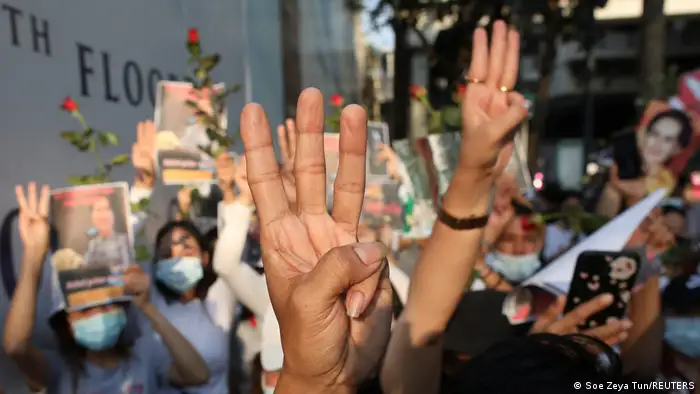
Pro-democracy protesters, seen here in 2021, use the three-finger salute as a gesture of defiance against the military regime
What strategies would you recommend countering the issue?
We are working on both long-term and short-term strategies to counter the military's propaganda and its impact on independent media.
- Research: Understanding the military regime's propaganda Combining quantitative and qualitative research techniques, our team investigates the propaganda strategies employed by the military and examines the way they disseminate their messages across various social media and messaging platforms. We actively monitor the disinformation activities of the military regime which enables us to issue early warnings on harmful content.
- Media and information literacy: Educating the public In order to bolster the resilience of Myanmar's society against disinformation and improve critical thinking, we are actively engaged in capacity building initiatives focused on fact-checking and media literacy skills. Through training sessions, workshops, networking opportunities and advocacy campaigns, we aim to equip individuals with the necessary tools to navigate the complex media landscape effectively. By educating the public on media and information literacy, we seek to empower them to discern truth from falsehood, particularly in the context of the post-coup environment in Myanmar.
- Supporting independent media: Strengthening fact-checking capacities By improving fact-checking capacities and investigative skills within independent media outlets, we aim to equip them with the tools needed to combat disinformation effectively. Through capacity-building initiatives, independent media can verify information, conduct thorough investigations and collaborate as a network to amplify verified content. It is imperative for independent media to promptly fact-check misinformation on social media platforms to mitigate its harmful effects. Moreover, efforts should be directed towards the localization of fact-checking initiatives, ensuring accessibility across different ethnic languages. Collaboration between local and international organizations supporting media and civil society is crucial in extending assistance for these initiatives. By providing increased support, these organizations can contribute significantly to the dissemination of accurate information and the empowerment of local communities throughout Myanmar.
- Advocacy: Engaging with social media platforms Our advocacy efforts are focused on ensuring accountability from social media platforms regarding the proliferation of harmful content in Myanmar. Despite monitoring by human rights activists and civil society organizations, platforms have been slow to address reports of content violations, even though they claim to uphold freedom of speech. While some channels have been banned, they often resurface, disseminating harmful content. Platforms must take responsibility by promptly and seriously addressing these contents and accounts, removing them in accordance with their own established rules and regulations.
This interview was conducted by Attila Mong via email.
This article is part of Tackling Disinformation: A Learning Guide produced by DW Akademie.
The Learning Guide includes explainers, videos and articles aimed at helping those already working in the field or directly impacted by the issues, such as media professionals, civil society actors, DW Akademie partners and experts.
It offers insights for evaluating media development activities and rethinking approaches to disinformation, alongside practical solutions and expert advice, with a focus on the Global South and Eastern Europe.
DW recommends
- Date 05.04.2024
- Author Attila Mong
- Feedback: Send us your feedback.
- Print Print this page
- Permalink https://p.dw.com/p/4e8n3
- Date 05.04.2024
- Author Attila Mong
- Send us your feedback.
- Print Print this page
- Permalink https://p.dw.com/p/4e8n3

